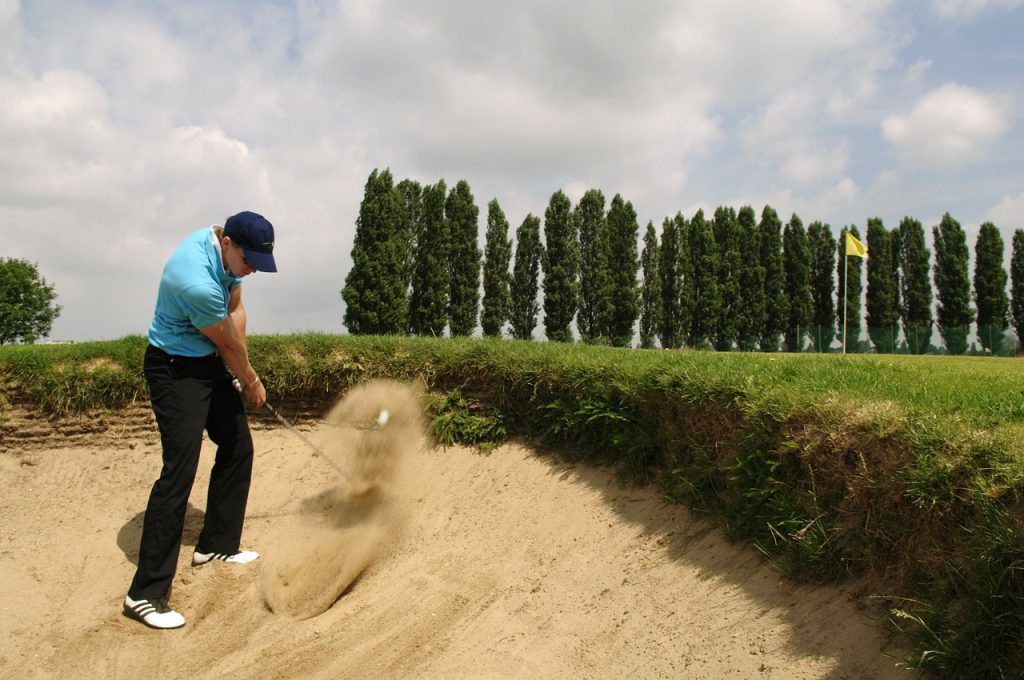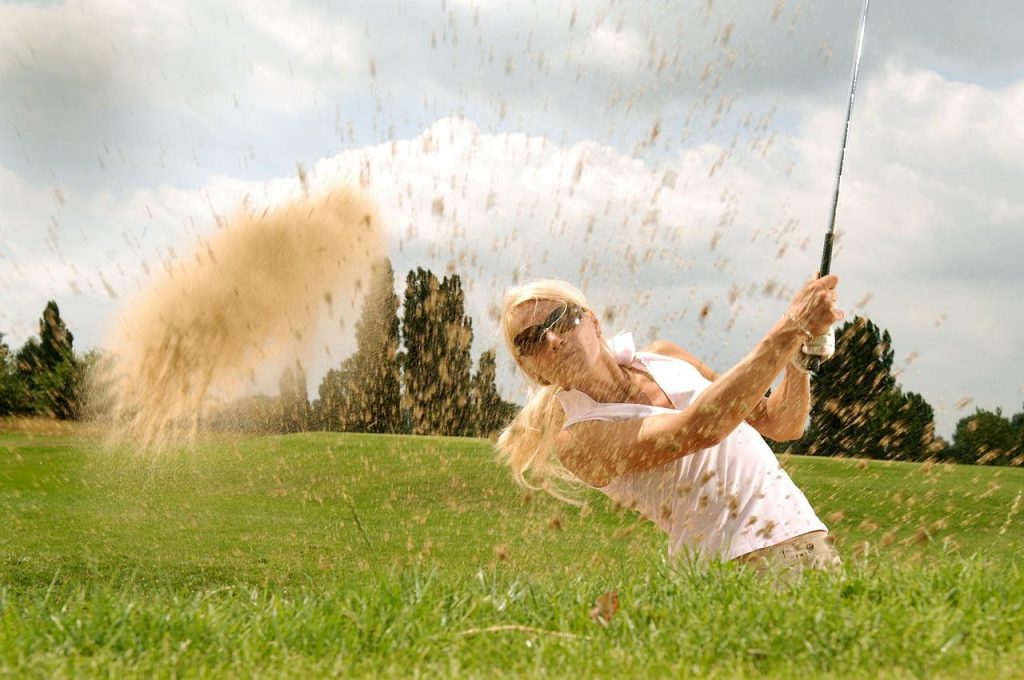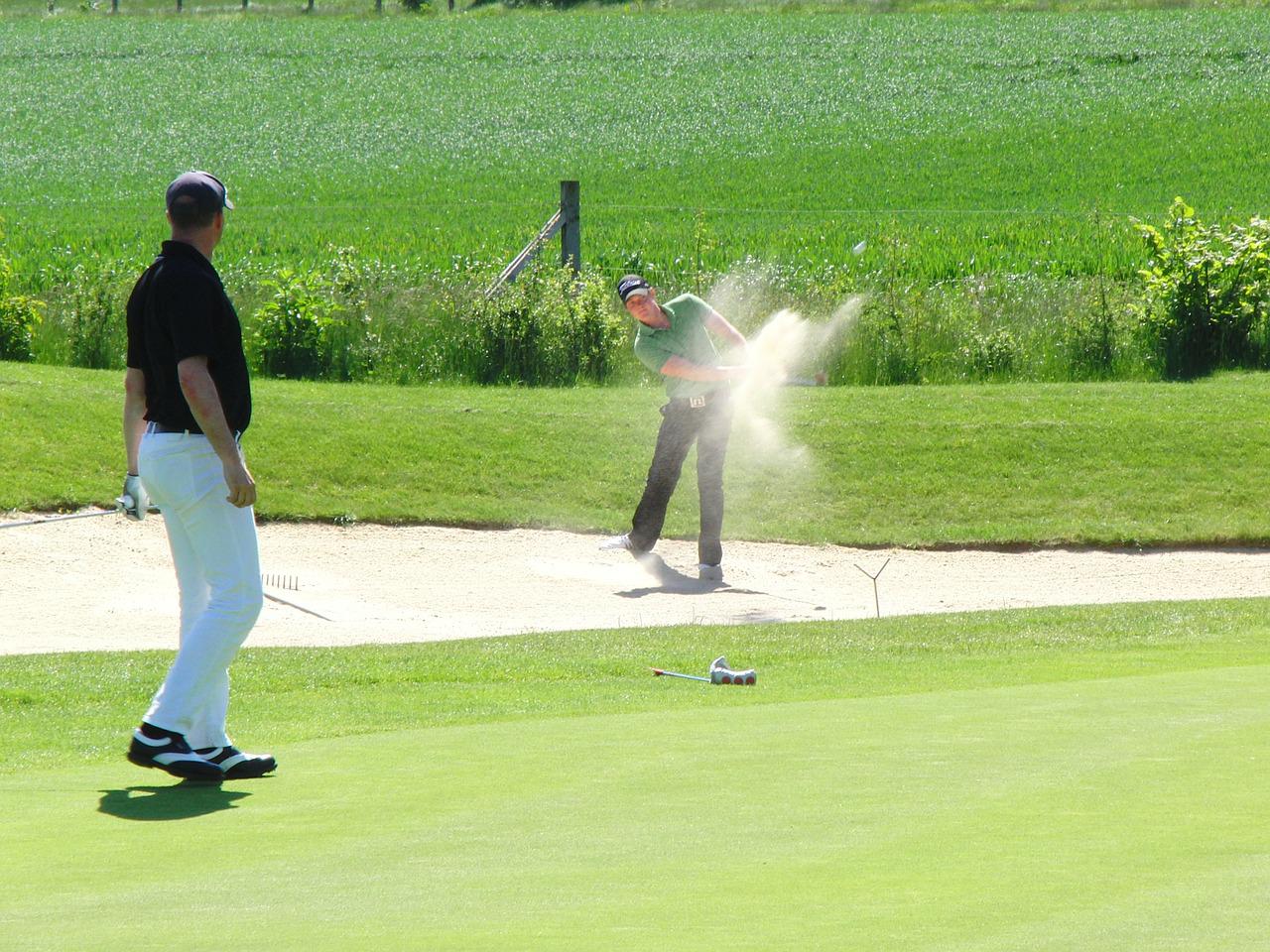How to Hit a Golf Ball Out of the Sand? There are a couple of simple tricks to hitting a golf ball out of the sand. First, keep your weight on your lead leg. Second, use the bounce of your sand wedge. Third, draw lines behind your ball using the bottom of your club. Then, focus on hitting your shot. Now, you can look forward to hitting the shot and think positively about it.
Keeping most of your weight on your lead leg
The first step in hitting a golf ball out of the saggy sand is to visualize your desired landing position. Once you have a clear image, adjust your clubface to expose some bounce to help your club glide through the sand. You should also play the ball closer to your target side foot while leaning more toward your lead leg.
Once you have the proper weight placement, the next step is to engage the swing arc. This will help you stay low and control your ball. If you are standing with your lead leg up, you should reduce the length of your swing, which will result in a shorter swing. Using your lead leg to move forward will help you stay low in the shot, which will improve your chances of hitting a golf ball out of the sand.
When hitting out of a bunker, you should aim to hit the sand between two and three inches behind the ball. To do this, picture taking a divot the size of a dollar bill. Try not to dig down into the sand, but instead, try to take a small divot with the ball.
Using a visual aid is a great way to introduce the proper weight shift to the lead leg. When you are in the sand, you can put a visual aid in front of the ball, such as a tennis ball, to help you swing through the sand. Make sure you are not swinging too hard. This is the easiest way to hit a golf ball out of the sand.

Using the bounce of a sand wedge
Choosing a wedge is important in hitting a golf ball out of the sAND. Wedges vary in bounce due to the amount of energy they have at impact. This can be a benefit on fluffy surfaces, but disadvantageous on tight turf. The amount of bounce will also depend on the grind and depth of the bounce. Using the right bounce will allow you to control the golf ball as it goes around the green.
Depending on the type of sand you play on, a high-bounce sand wedge can be a good choice for softer sand. It is less likely to dig into the ground, making it suitable for players who have a steeper angle of attack. Sand wedges are generally designed with a higher bounce for softer sand, while low-bounce ones are better suited for tight lies and thin bunker beds.
Most recreational golfers focus on loft, but the bounce of sand wedges is just as important. Using the bounce of a sand wedge to hit a golf ball out of the sand is a good way to add forgiveness to your shots. You may want to try both bounce degrees before you decide on which one is best for you. The ten to fourteen-degree bounce wedges are the most common ones. You may want to try a wedge that is higher-bounce if you plan to pick up golf balls or take large divots.
Choosing the correct wedge for soft sand can be challenging. High-bounce wedges are a good option for golfers who want to hit shots around the green without digging deep into the ground. High-bounce sand wedges are ideal for soft sand because they allow you to get under the ball and generate spin while on the green. The best type of wedge for soft sand lies is 14 degrees.
Drawing lines in the sand behind your ball
Draw a line in the sand in the area you want to hit the ball. Practice hitting the sand in the place you want to hit it, and learn to identify the size of the ball. Practice hitting the sand at different angles, while keeping a slightly open stance. Try hitting the sand at about 10o off the line.
After creating the sand line, draw a second one in the opposite direction. The first one should be at the base of the ball, while the second one should be at the top of your stance. The ball should be placed on the handle line below your top, slightly ahead of center. Then, when swinging the golf club, trace the arc of the top line of the umbrella. As you do this, make sure to push your sternum forward while swinging the club. You should see that the clubhead enters the sand behind the ball and exits in front of the ball.
If you’re unsure of how to hit a golf ball out of the bunker, try practicing different shots. You can practice by drawing lines in the sand behind your ball with a sand wedge. During the practice swing, drive the bottom of the club into the sand with the outside-to-inside path. Afterward, take a swing with the clubface open, and you’ll see the ball pop out of the sand and land softly on the green.
When you’re ready to hit the shot, you should make sure you’re in good position. Dig deep with your feet and open your stance. When you’re in a bunker, you should be aiming about two inches behind the ball, and aim to hit the line just before impact. This technique will help you get an accurate shot.

Using the bottom of the club
Rather than open up your face with the golf club, try using the bottom part of the club to hit a golf ball. You will need to turn your toe slightly away from the ball to open your clubface and hit the sand with the bottom part of your clubface. If you do not turn your toe, your ball will dig into the sand and the shot won’t travel far or fly high.
The next step is to play the ball forward. If you’re in a thick greenside rough, you’ll want to hit the ball in the middle. As your swing begins, lean forward slightly, aiming at the ball. Your clubface will strike the sand two inches behind the ball. When the ball lands, the bottom of the club will make the distinctive “spanking” sound.
The bottom part of the club is crucial to hitting golf balls out of the sand. Using the bottom of the club will help you control the ball and ensure that the golf ball will fly out. The bottom part of the club will also prevent the golf ball from digging into the sand. You’ll be able to get a higher ball flight if you stay connected during the entire swing.
Another tip for hitting a golf ball out of the ssand is to close your clubface. This will make it easier to control the clubface. By avoiding the back of the sand, the bottom will hit the sand first and propel the ball forward. It’s best to place two-thirds of your weight toward your front foot.
Thinned shots when hitting out of hard bunker sand
If you’re trying to hit a golf ball out of a hard bunker sand, a thicker clubface may be a better choice than a thin one. While the sand in a hard bunker can seem compact, you must remember to open the clubface to make contact with the equator of the ball. Then, make sure to accelerate quickly.
In a bunker, the best way to prevent a thin shot is to hit a softer club. A thinned shot is a shot that has very little loft and will create a divot on impact. To prevent a thin shot, try to make contact with the ball at the center of your stance. A thinner clubface will make it easier for your clubface to remain pointed skyward during impact, and the cutting edge of the club will slice the sand.
The first step in using a thinned shot is determining the exact amount of sand behind the ball. If there is more than one inch of sand behind the ball, the club will be too heavy and slow the ball down. Make sure to set up the club with control by placing the grip down. You should also aim for the ball to skim the sand. Because the club’s leading edge is so sharp, it will cut through the sand.
To avoid a thinned shot in a hard bunker sand, remember to open the stance and set your wrists early to create an optimum position. To make a proper strike in a bunker, aim the clubface towards the intended line and strike the sand approximately an inch behind the ball. The downswing will help the ball to exit the bunker.


